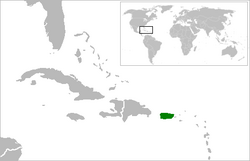| Antillean cave rail Temporal range: | |
|---|---|
 | |
| Leg and foot bones | |
| Scientific classification | |
| Kingdom: | Animalia |
| Phylum: | Chordata |
| Class: | Aves |
| Order: | Gruiformes |
| Family: | † Nesotrochidae |
| Genus: | † Nesotrochis |
| Species: | †N. debooyi |
| Binomial name | |
| †Nesotrochis debooyi Wetmore, 1918 | |
 | |
| Location of Puerto Rico. | |
The Antillean cave rail (Nesotrochis debooyi), also known as DeBooy's rail, is an extinct species of flightless bird which occurred on Puerto Rico and the United States Virgin Islands. [1]